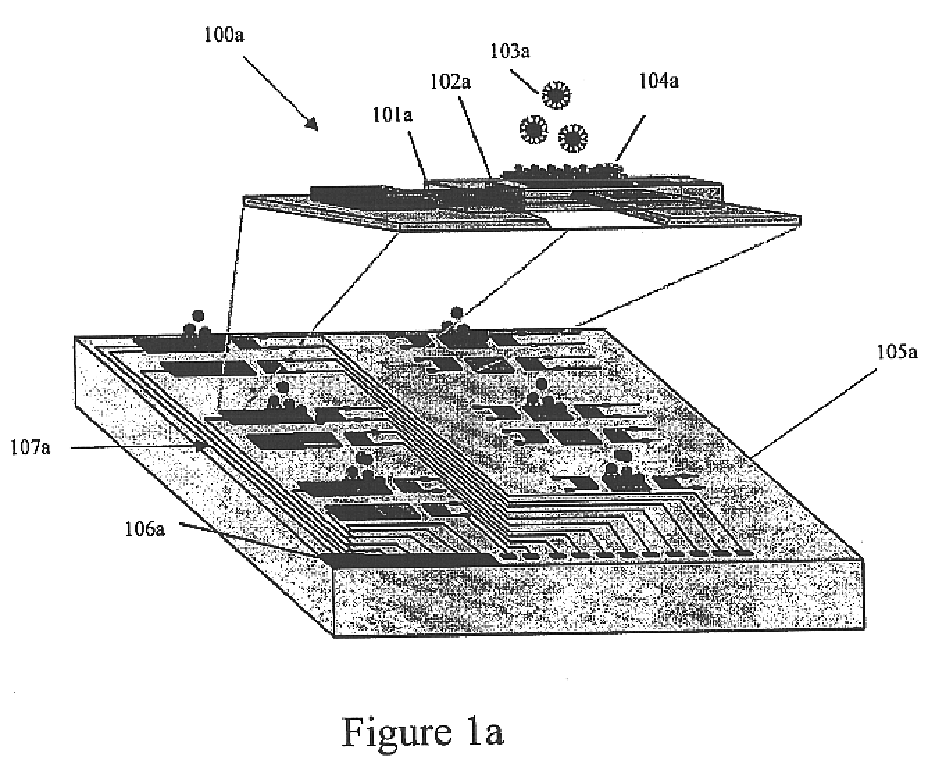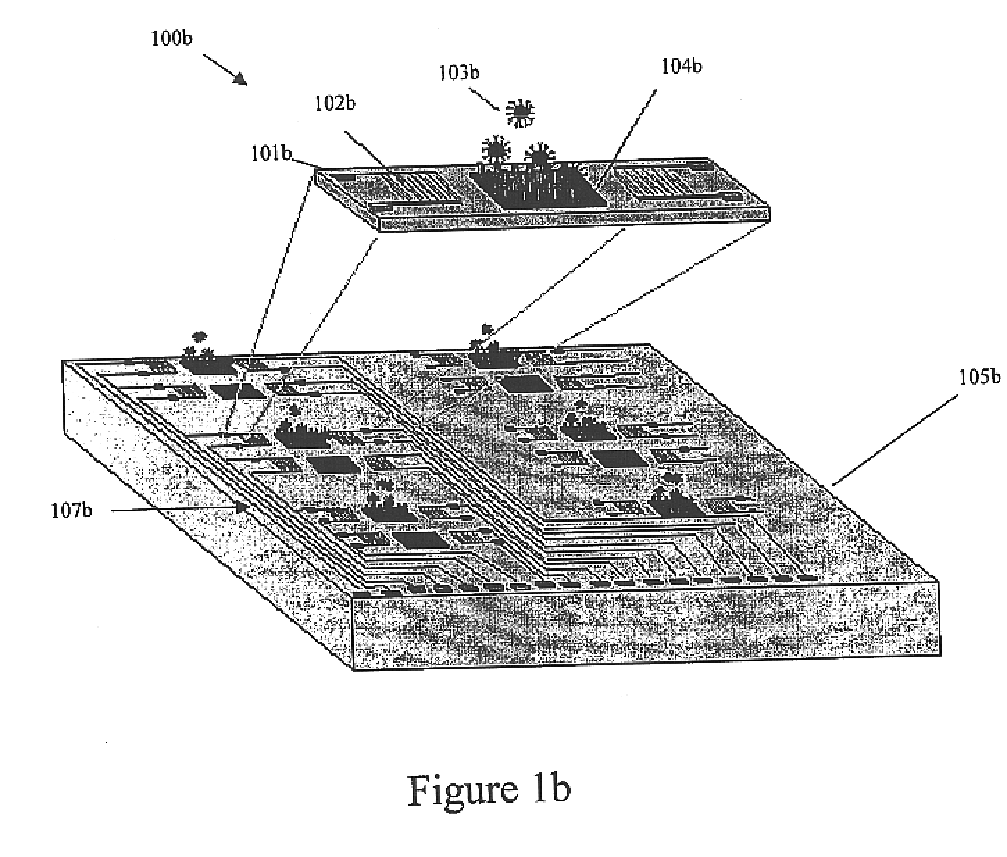The exemplary embodiments and / or exemplary methods of the present invention involve the use of wide BANDGAP aluminum
nitride (AlN)
semiconductor materials in acoustic wave (AW) devices for use as chemical and biological sensors. Compared to other piezoelectric materials that may be used for AW devices, it is believed that aluminum
nitride (AlN) may provide advantages because of its relatively fast acoustic velocity, high
electromechanical coupling coefficient, near linear
temperature coefficient, and / or high stability in relatively harsh environments. Furthermore, it is believed that AlN may permit
hybrid integration of the AW sensors with other VLSI
electronics because of the compatibility of AlN with Si. As such, AlN may provide an appropriate platform for providing ultra-sensitive AW sensors integrated with a microchip.
The exemplary AlN-based AW sensor or
biosensor may provide further benefits. A
biosensor may include
receptor molecules integrated with a
transducer for use in detection. Any intrinsic selectivity may arise from the specific nature of bio-recognition reactions (such as, for example,
antibody-
antigen,
enzyme-substrate,
complementary DNA strands, etc.), and may depend on the
coupling between the recognition reaction and the
transducer, as well as the inherent sensitivity of the
transducer. Using an AlN-based acoustic wave arrangement as a common sensor platform for integration with the sensing medium, immobilization layer
polymer viscoelectric properties or
metal mechanical properties of the wave arrangement may result in significant changes in such acoustic wave characteristics when the arrangement contacts liquid. Moreover, the motion at the surface of the arrangement may entrain a
liquid layer at the surface and propagate a damped shear wave into the liquid. Thus, an AlN-based AW
biosensor may operate not only as a SAW-based arrangement (SAW mode), but also as a STW-based arrangement (STW mode), so as to be operable in an air or liquid environment. In particular, the AlN-based biosensor may operate most, or at least more, sensitively in air via the SAW mode and, additionally, the AlN-based biosensor may operate most, or at least more, sensitively in water via the STW mode. Therefore, different devices may not be required to operate in air and water. Furthermore, such a
dual mode operation may be useful in applications such as
robotic sensing, in which the
biosensor device may provide an ability to discriminate between liquids and solids.
It is believed that advantages of the exemplary embodiments and / or exemplary methods of the present invention may include optimized biosensor devices, improved biosensor arrangement performance, determination of effective sensing media immobilization approaches, and AlN-based biosensors that may be used to provide continuous, in-situ, and
rapid detection and quantification of analytes in samples.
In this regard, the exemplary embodiments and / or exemplary methods of the present invention are directed to providing (i) wide bandgap semiconductors; (ii) new
processing approaches for forming biosensor structures; (iii) integrating new organic and inorganic immobilization structures and embedding them in chemical and / or biological binding sites; (iv) developing
wide bandgap semiconductor wave guide arrangements; and (v) integrating the biosensor arrangement as an array in a sensing architecture and other associated
integrated electronics on a
chip. Furthermore, integrating such an arrangement on a
chip and providing new fabrication technologies may provide an array of other potential
chip devices. The present
subject matter may also be used in developing other
wide bandgap semiconductor and
semiconductor-organic arrangements in non-electronic devices on a chip.
Rapid detection,
remote sensing, and relatively low cost may also be provided. It is believed that AlN-based acoustic wave biosensors may provide reliable and faster detection of specific analytes at a lower cost. Thus, it is believed that the AlN-based sensors may provide a new class of economical and portable biosensor arrangements that may detect desired analytes more sensitively and more rapidly, including their use in continuously monitoring contaminated areas.
An exemplary method of the present invention is directed to making an acoustic wave sensor, in which a substrate is ultrasonically cleaned, the substrate is etched in a heated acid mixture to remove damage caused by a mechanical
polishing, the substrate is rinsed in de-ionized water and
methanol, the substrate is loaded into a
plasma source molecular
epitaxy growth chamber, the substrate is preheated, and the temperature is raised to grow a layer on the substrate.
 Login to View More
Login to View More  Login to View More
Login to View More 


